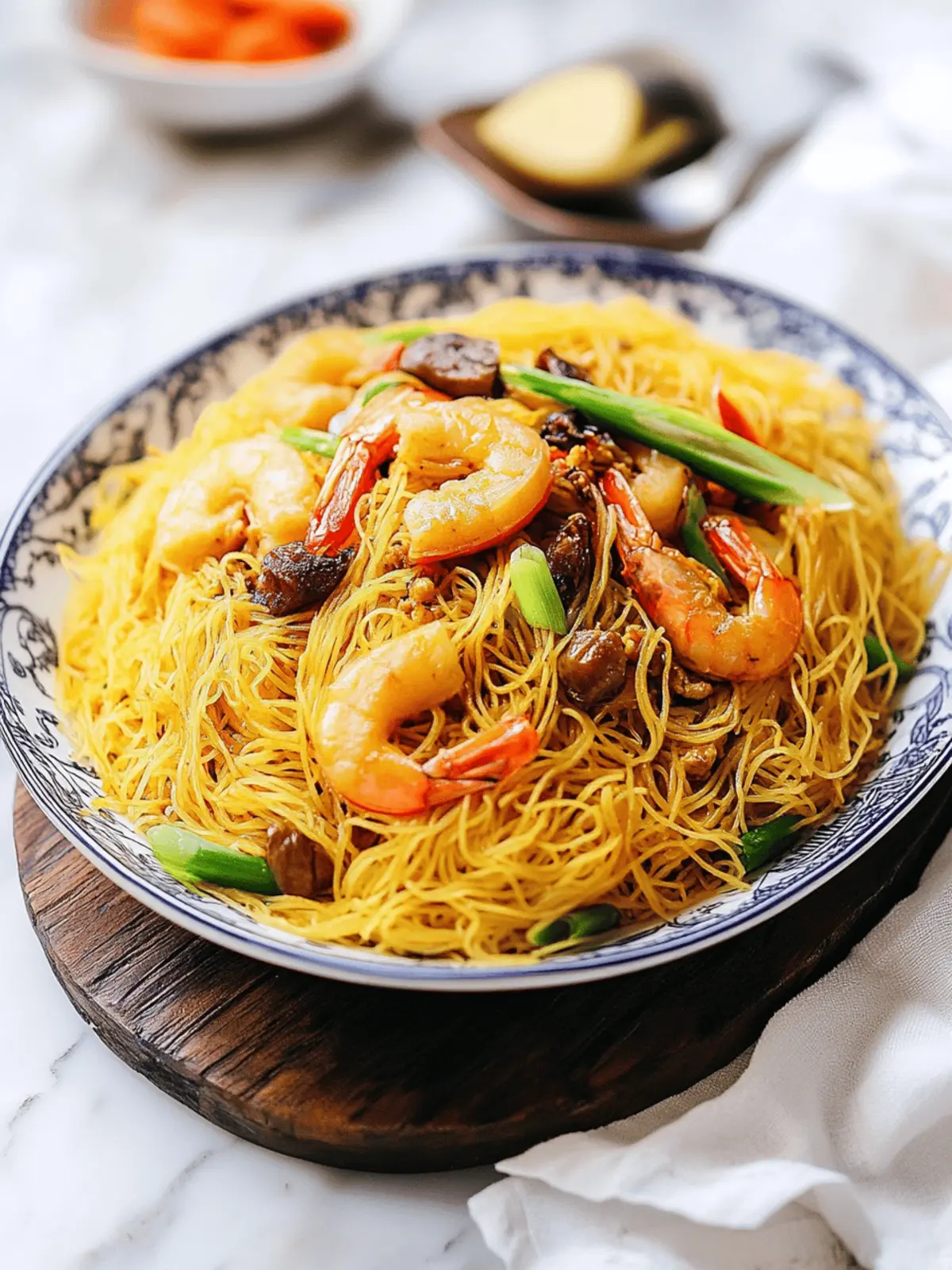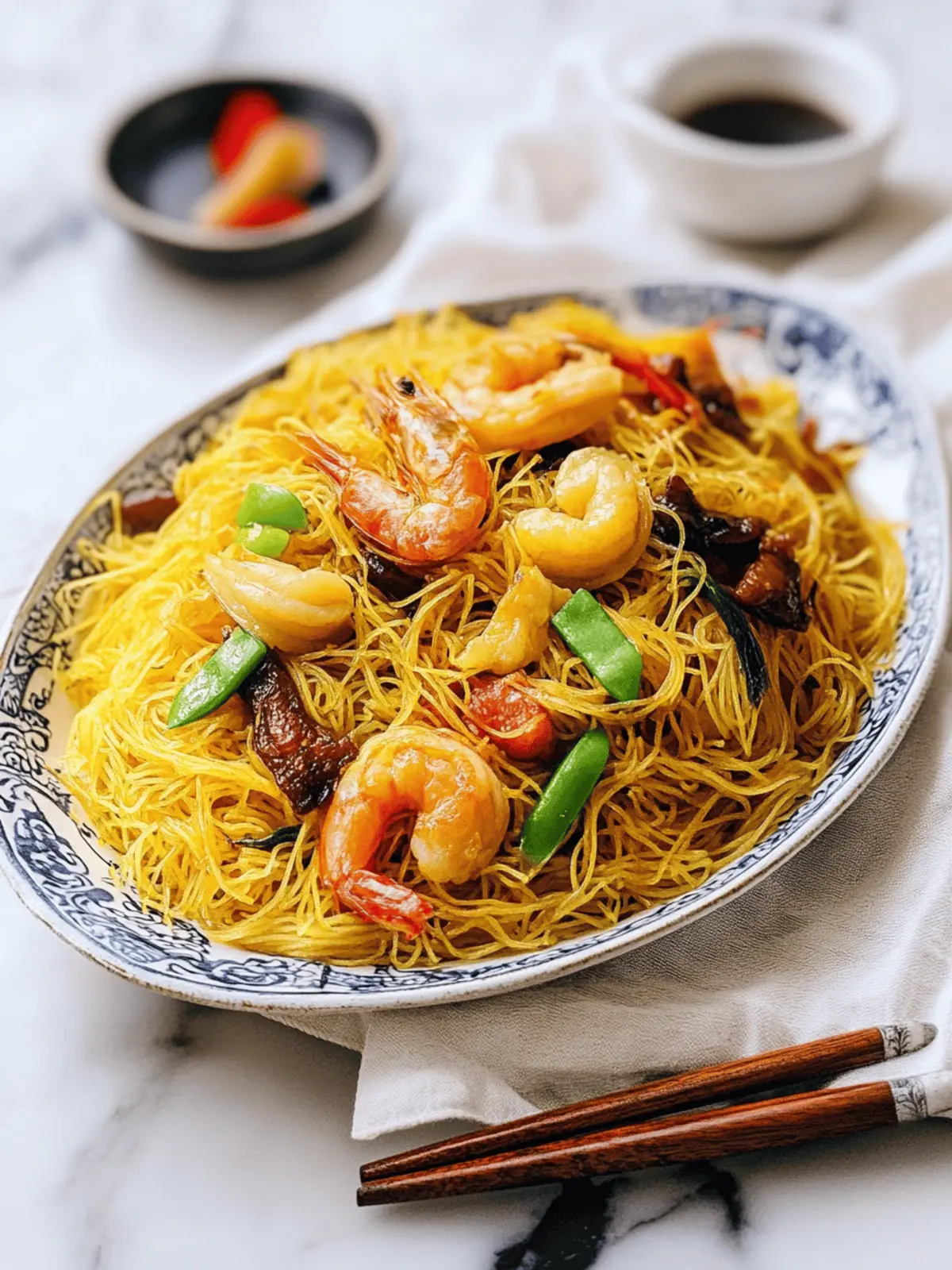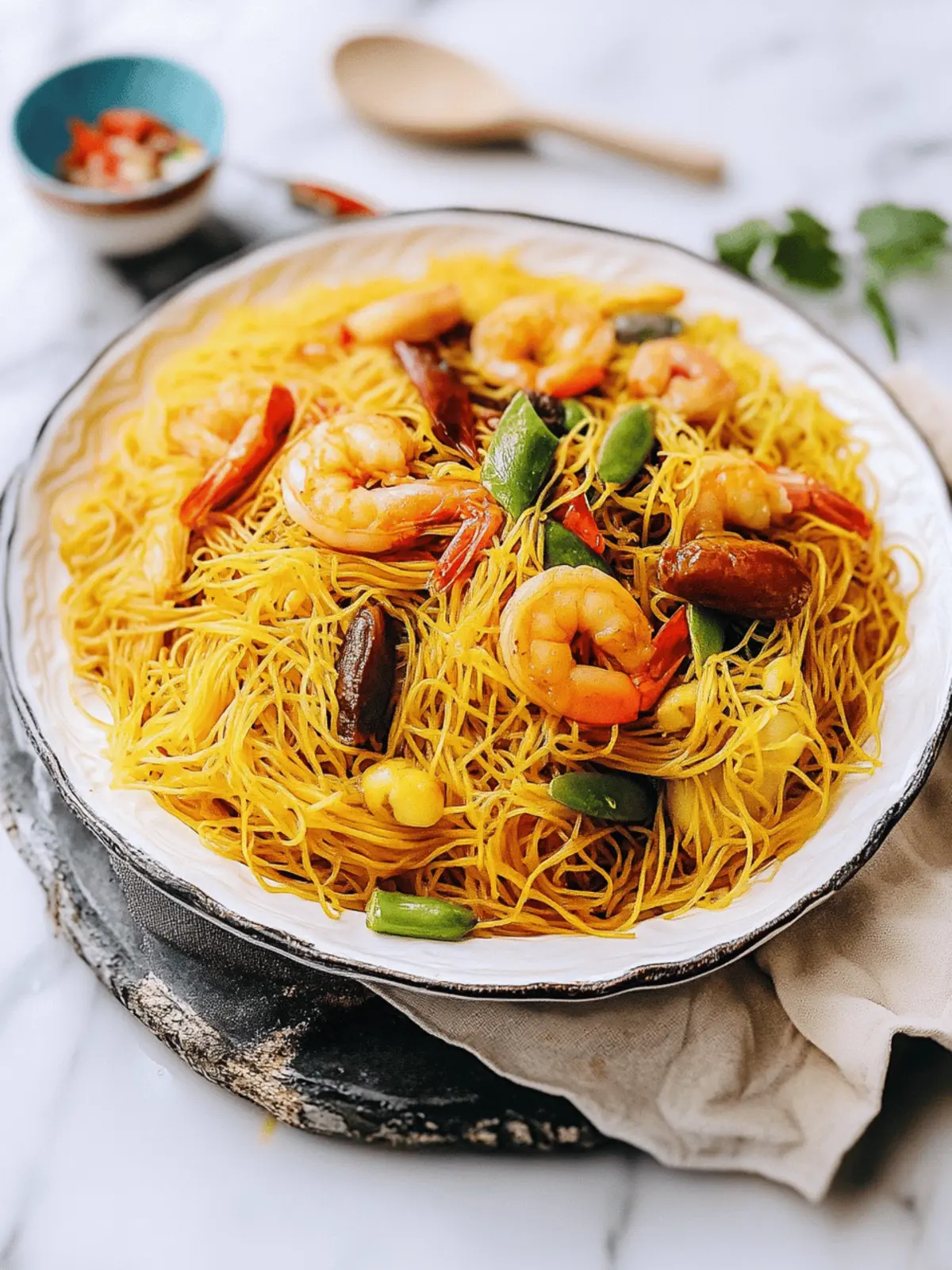When the craving for vibrant, flavorful meals strikes, nothing tantalizes my taste buds quite like Singapore Noodles. This dish is a delightful whirl of tender rice vermicelli, succulent shrimp, and colorful vegetables, all tossed in a light curry seasoning that elevates the humble stir-fry into something extraordinary. On those hectic weeknights, my go-to solution is this quick and easy recipe that transports me straight to the streets of Singapore in just 35 minutes.
Last week, I found myself in a cooking rut, where takeout seemed like the only option. But with just a few ingredients in hand—including shrimp, char siu, and crunchy napa cabbage—I decided to whip up a batch of these noodles. The result? A satisfying bowl that not only quenched my takeout cravings but also brought a comforting touch of home-cooked goodness to the table. Whether you’re in need of a fragrant meal for yourself or a crowd-pleasing dish for entertaining, these Singapore Noodles are sure to impress and delight. So, let’s dive in and turn your kitchen into a bustling Asian bistro!
Why are Singapore Noodles a must-try?
Vibrant Flavor: Singapore Noodles are a colorful medley of shrimp, char siu, and fresh vegetables, all enveloped in a light curry flavor that excites the palate.
Quick Preparation: Ready in just 35 minutes, this recipe is perfect for those hectic weeknights when time is of the essence but flavor is non-negotiable.
Customizable: Easily swap proteins or change up the veggies based on your preferences or what you have on hand—making it ideal for any dietary needs!
Comfort of Home: Enjoy a takeout favorite with the warmth and satisfaction that only home-cooked meals can provide.
Crowd-Pleaser: Whether for a family dinner or entertaining friends, this dish is sure to impress guests with its gorgeous presentation and delightful taste.
For tips on adapting ingredients, check out my guide on customizing your noodle dishes.
Ingredients for Singapore Noodles
For the Noodles
• Dried vermicelli rice noodles – This is the base of the dish, offering a great texture; opt for thin rice noodles for the best results.
For the Protein
• Large shrimp (12 pieces) – These add a sweet, seafood flavor; feel free to substitute with smaller shrimp for convenience.
• Char siu (4 ounces, Chinese Roast Pork) – Brings a deliciously savory depth; substitute with Virginia ham or Chinese sausage for different flavors.
• Eggs (2, beaten) – Adds richness and protein; pre-scrambling makes for an easier sauté later.
For the Vegetables
• Napa cabbage (9 ounces, shredded) – Adds a delightful crunch; savoy or green cabbage can be substituted if needed.
• Carrot (1 medium) – Offers sweetness and color; julienne it for even cooking.
• Garlic (2 cloves, chopped) – Acts as a fragrant aromatic that elevates the dish.
• Dried red chili peppers (3) – Optional for heat; adjust according to your spice preference.
• Scallion (1, julienned) – A fresh garnish that enhances the flavor profile.
• Red onion (1/2 medium, thinly sliced) – Adds bite and sweetness; can be omitted for a milder taste.
For the Seasoning
• Curry powder (2 tablespoons, or to taste) – The key ingredient that defines Singapore Noodles; adjust for spiciness as desired.
• Salt (1 teaspoon, or to taste) – Enhances all flavors; please adjust to meet dietary needs.
• Sugar (1/4 teaspoon) – Balances the dish’s flavors beautifully.
• White pepper (1/8 teaspoon) – Introduces subtle warmth; optional if you prefer no heat.
For Cooking
• Vegetable oil (2.5 tablespoons) – Essential for high-heat stir-frying; ensures everything cooks evenly.
• Shaoxing wine (1 tablespoon) – Adds a wonderful depth of flavor; dry cooking sherry can be a convenient substitute.
• Chicken stock or water (2-4 tablespoons) – Use to adjust moisture if noodles appear dry.
• Sesame oil (1/2 teaspoon) – Adds a nutty richness; choose high-quality for the best flavor.
• Soy sauce (1.5 teaspoons) – Provides umami goodness; opt for gluten-free soy sauce if needed.
Remember, the vibrant flavors of these Singapore Noodles are just a few ingredients away!
How to Make Singapore Noodles
-
Prepare Noodles: Rehydrate the dried vermicelli rice noodles using your preferred method—either soak them in cold water overnight, use hot water for about 30 minutes, or boil for just 1 minute. Drain well and cut them into 8-10 inch pieces for easier handling.
-
Prep Shrimp: Carefully peel and de-vein the large shrimp. If you’re using larger ones, consider butterflying them for an elegant look; smaller shrimp can remain whole. Pat them dry to ensure a nice sear.
-
Cook Eggs: In a heated wok, add 1 tablespoon of vegetable oil. Pour in the beaten eggs and cook until they are soft and scrambled. Remove from the wok and set aside.
-
Stir-Fry: Heat the remaining oil in the wok, then add the chopped garlic, shrimp, and char siu. Stir-fry for just a minute, then splash the Shaoxing wine around the perimeter of the wok and mix it in.
-
Add Vegetables: Stir in the dried chili peppers, shredded napa cabbage, and julienned carrot. Cook for approximately 30 seconds until the vegetables are slightly tender yet still crisp.
-
Combine Noodles: Introduce the rehydrated rice noodles to the wok, and stir-fry them carefully, loosening any delicate noodles for about 1 minute until they are coated with the flavors.
-
Season: Sprinkle the curry powder, salt, sugar, and white pepper over the noodles. Stir-fry for about 2 minutes to ensure even seasoning, and adjust the moisture with chicken stock or water if the noodles are looking a bit dry.
-
Finalize: Mix in the sesame oil, soy sauce, last scrambled eggs, julienned scallions, and sliced red onion. Stir-fry for an additional minute until everything is heated through and delicious.
-
Serve: Plate the Singapore Noodles hot and offer chili oil on the side for those who like an extra kick!
Optional: Garnish with additional scallions or sesame seeds for a delightful finish.
Exact quantities are listed in the recipe card below.
Make Ahead Options
These Singapore Noodles (Singapore Mei Fun) are perfect for busy weeknights and can save you precious time when meal prepping! You can prepare the vegetables and proteins—like the shrimp and char siu—up to 24 hours in advance; just keep them refrigerated in airtight containers to preserve freshness. For an even quicker setup, rehydrate the rice noodles and store them separately; they’ll stay great in the fridge for about 3 days. When you’re ready for a delicious meal, heat your wok, stir-fry everything together, and finish with the sauce and seasonings as outlined in the recipe. This way, you’ll enjoy the same vibrant flavors without the last-minute rush!
Singapore Noodles Variations
Feel free to get creative with these Singapore Noodles to suit your taste and dietary needs!
-
Vegan Option: Replace shrimp and char siu with tofu and extra vegetables like bell peppers and snap peas for a delightful veggie-packed dish.
-
Gluten-Free: Use gluten-free soy sauce and ensure your vermicelli noodles are certified gluten-free for those with dietary restrictions.
-
Extra Spicy: Add more dried chili peppers or a dash of chili paste to amp up the heat and excite your taste buds.
-
Curry Twist: Experiment with different curry powders, like Thai red or yellow curry, to give your noodles a unique flavor profile.
-
Seafood Medley: Mix in other seafood options such as calamari or scallops for a different twist on this classic dish.
-
Noodle Variety: Swap out rice vermicelli for other types of noodles such as soba or udon for a new texture experience.
-
Crunchy Toppings: Top with toasted sesame seeds or crushed peanuts for an added crunch and depth of flavor.
-
Sweet Flavor Boost: Incorporate a tablespoon of sweet chili sauce during the stir-fry for a sweet and savory combination that will have everyone asking for seconds.
How to Store and Freeze Singapore Noodles
Fridge: Store leftovers in an airtight container in the refrigerator for up to 3 days. When ready to enjoy, reheat gently in a wok or pan to prevent overcooking the noodles.
Freezer: For longer storage, freeze Singapore Noodles in airtight containers or freezer bags for up to 3 months. To reheat, defrost in the fridge overnight, then stir-fry in a hot wok until heated through.
Room Temperature: Avoid leaving cooked Singapore Noodles at room temperature for more than 2 hours to prevent spoilage.
Reheating: When reheating, add a splash of water or chicken stock to the pan to help restore moisture and flavor, ensuring a delicious second round of this tasty dish!
Expert Tips for Singapore Noodles
• Hot Wok Essentials: Ensure your wok is preheated before adding ingredients to prevent sticking and achieve perfect caramelization.
• Ingredient Prep First: Measure and prepare spices and vegetables beforehand for a smooth cooking process and no last-minute rushing.
• Noodle Moisture Alert: Keep an eye on the noodles. Slightly wetter noodles retain more flavor, so use chicken stock or water if they appear dry.
• Customizable Veggies: Feel free to swap or add vegetables based on your preference or availability, but keep the cuts uniform for even cooking.
• Protein Substitutions: For different dietary needs, swap shrimp with chicken, beef, or tofu while maintaining the essence of delicious Singapore Noodles.
• Season to Taste: Adjust the curry powder and other seasonings according to your spice level preference for a dish that hits all the right notes.
What to Serve with Singapore Noodles?
Elevate your Singapore Noodles experience with delightful sides and pairings that complement the vibrant flavors of this dish.
-
Cucumber Salad: A refreshing crunch that balances the warm spices of the noodles, this salad adds a cool and vibrant note to your meal. Toss together sliced cucumbers with a light vinegar dressing for a zesty contrast.
-
Chili Oil: For those who love a kick, serving chili oil on the side allows you to customize the heat level of your dish, enhancing the spicy notes of the curry. This simple addition can take your noodle experience to a new level of deliciousness.
-
Steamed Dumplings: Soft, savory dumplings provide a delightful texture contrast while harmonizing wonderfully with the flavors of Singapore Noodles. Serve them with a soy dipping sauce for an irresistible bite-sized treat.
-
Spring Rolls: Crispy outside and filled with fresh and vibrant flavors, spring rolls add a fun crunch to the meal, making it a delightful experience to munch on alongside the noodles.
-
Light Beer or Lemonade: Pair your meal with a refreshing drink like a crisp light beer or homemade lemonade. The acidity will brighten the flavors and cleanse your palate between bites.
-
Mango Sticky Rice: End on a sweet note with this classic dessert. The creaminess of the coconut and sweetness of the mango perfectly balance the savory elements of Singapore Noodles, creating a harmonious meal experience.
Each of these pairings will not only enhance your Singapore Noodles but also create a delightful and memorable dining experience.
Singapore Noodles (Singapore Mei Fun) Recipe FAQs
What type of rice noodles should I use for Singapore Noodles?
Absolutely! For Singapore Noodles, use dried vermicelli rice noodles, specifically the thin ones. It’s crucial to avoid mung bean noodles, as they have a different texture. Look for packages labeled “rice vermicelli” to find the right kind!
How can I store leftovers of Singapore Noodles?
Very! Store any leftover Singapore Noodles in an airtight container in the refrigerator for up to 3 days. When you’re ready to eat, simply reheat them gently in a wok or frying pan to avoid overcooking the noodles.
Can I freeze Singapore Noodles?
Yes, you can! To freeze, place the Singapore Noodles in airtight containers or freezer bags, making sure to remove as much air as possible. They can be frozen for up to 3 months. When time to enjoy again, defrost them overnight in the refrigerator, and then stir-fry in a hot wok for best quality.
What should I do if my noodles turn out too dry?
If your noodles seem dry after cooking, don’t worry! You can add a splash of chicken stock or water while stir-frying to moisten them and bring back the flavors. Additionally, always monitor the moisture levels during cooking and err on the side of a slightly wetter noodle for flavor retention.
Are there any dietary considerations for Singapore Noodles?
Absolutely! You can make Singapore Noodles gluten-free by using gluten-free soy sauce and ensuring that your noodles are labeled as gluten-free. If you have allergies, check the char siu or any other pre-packaged ingredients for potential allergens. Moreover, for a vegan/vegetarian version, substitute shrimp and char siu with tofu or your favorite vegetables, while still enjoying the delicious curry flavors!
How can I tell if my ingredients are fresh?
For the best flavor and texture, ensure your ingredients are fresh. Look for shrimp with a firm texture and a mild sea scent, not ‘fishy.’ For vegetables, avoid any with dark spots or wilting. Freshness truly matters in enhancing the delightful taste of your Singapore Noodles!

Savor Singapore Noodles (Singapore Mei Fun) in 35 Minutes
Ingredients
Equipment
Method
- Prepare Noodles: Rehydrate the dried vermicelli rice noodles using your preferred method, then cut them into 8-10 inch pieces.
- Prep Shrimp: Peel and de-vein the large shrimp; pat dry.
- Cook Eggs: Heat 1 tbsp of vegetable oil in a wok, cook the beaten eggs until soft and scrambled, then set aside.
- Stir-Fry: Heat remaining oil in the wok, add garlic, shrimp, and char siu; stir-fry for a minute and splash in Shaoxing wine.
- Add Vegetables: Stir in dried chili peppers, napa cabbage, and carrot; cook for 30 seconds.
- Combine Noodles: Add rehydrated noodles and stir-fry carefully for about 1 minute.
- Season: Add curry powder, salt, sugar, and white pepper; stir-fry for 2 minutes.
- Finalize: Mix in sesame oil, soy sauce, scrambled eggs, scallions, and red onion; stir-fry until heated through.
- Serve: Plate the Singapore Noodles hot with chili oil on the side.



